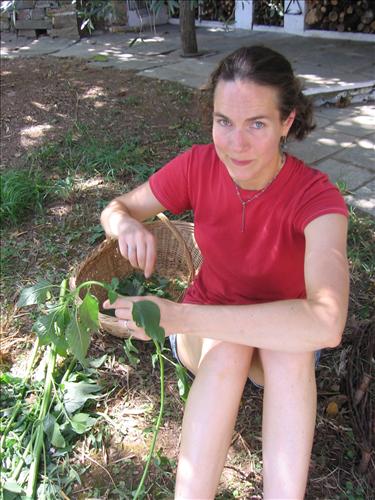Powdery Mildew on my Sage: A Home Remedy
 I was strolling through an open air market last summer and bought a huge sage plant at a discount. It was glorious. I brought it home dreaming of ravioli with sage-butter sauce and even crisp fried sage leaves as a snack (the best alternative to potato chips there is!), but after about a week the plant developed powdery mildew. See the little white spot on the leaf in the middle? That's it. It's insidious. I fought a losing battle all last summer and fall. When I cut the whole plant down to the stalks in early winter, I hoped that freezing temps over the season would put an end to the bug. They didn't, so here's a home recipe for an anti-powdery mildew spray:
I was strolling through an open air market last summer and bought a huge sage plant at a discount. It was glorious. I brought it home dreaming of ravioli with sage-butter sauce and even crisp fried sage leaves as a snack (the best alternative to potato chips there is!), but after about a week the plant developed powdery mildew. See the little white spot on the leaf in the middle? That's it. It's insidious. I fought a losing battle all last summer and fall. When I cut the whole plant down to the stalks in early winter, I hoped that freezing temps over the season would put an end to the bug. They didn't, so here's a home recipe for an anti-powdery mildew spray:1 cups tap water
1/4 tsp baking soda
Place into a spray bottle. Saturate leaves in the morning so they have a chance to dry out in the afternoon sun. Since powdery mildew thrives in moisture, you want to limit the time the leaves are wet. Also, if possible, water the plant from the bottom by filling the saucer with water. So, this seems a bit paradoxical. You should spray with a water solution to get rid of powdery mildew but you should keep the plant's leaves dry to retard powdery mildew growth. I dunno; for now that's the best I got.
Now if anybody out there has any better home remedies, please let me know.


10 Comments:
Yikes Susan! And here I thought we had a problem with whatever that is using our sage bush as a merenda (and it's NOT Maddie). There are nibble marks on just about every leaf. I don't mind sharing, but you'd think that it could just stick to one leaf and finish it off---the greedy thing!
its that all italian food?? need to try it!
This comment has been removed by the author.
I felt very happy to read the article "Powdery Mildew on my Sage: A Home Remedy". Thank you so much for such an informative information.
”Home Remedy”
I once had a little tree (I can't remember what it was... a houseplant when I lived in South Florida) that developped just such a mold. A friend who had a VERY green thumb told me to wipe down all the leaves & entire trunk with rubbing alcohol-soaked cotton balls. I did that a few times... even LEFT an alcohol-soaked cotton ball on a few particularly difficult locations. It worked, and the tree became healthy and lush afterward.
Don't know if I'd do that with an herb plant... might be worth a try.
About mildew, one idea would be to heat the plant
for a brief period at 90-95F:
http://www.practicalwinery.com/marapr03/marapr03p16.htm
This also suggest garlic spray (it contains sulfur) besides
baking soda but you probably already know it:
http://www.gardenguides.com/pests/tips/powderymildew.asp
Hi Everybody, Thanks for the tips. The above suggestion about heating the pland comes from someone who e-mailed me, not from myself.
The baking soda solution seems to do something but not enough. I want to eradicate the thing. Alcohol-soaked cotton balls might not be a bad idea; I'll try that on one leaf and see if it holds up. Otherwise, I'm willing to try the heating to 95F method. I mean, on hot summer days the temps get that high, so that shouldn't hurt the plant. I'll let you all know how it goes.
Good luck!
From the Oxford Companion to Wine:
he disease develops and spreads most rapidly in warm weather, 20 to 27 °C (68–80 °F). Unlike all other fungal diseases of vines, this one is little affected by humidity, making climate conditions which favour it different from those which favour many others. Powdery mildew is favoured by dense, shaded canopies. In fact, bright sunlight inhibits the germination of spores. Fortunately the control of this disease was discovered soon after it appeared in Europe. Mr Tucker noted the similarity between this vine disease and that affecting peach trees which could be controlled by a mixture of sulfur, lime, and water. Dusting with sulfur was accepted after the disastrous French vintage of 1854, the smallest since 1788. This same technique is still used today.
I love trying homemade solutions like this spray.
Post a Comment
<< Home